An-Chieh Cheng
3D Aware Region Prompted Vision Language Model
Sep 16, 2025Abstract:We present Spatial Region 3D (SR-3D) aware vision-language model that connects single-view 2D images and multi-view 3D data through a shared visual token space. SR-3D supports flexible region prompting, allowing users to annotate regions with bounding boxes, segmentation masks on any frame, or directly in 3D, without the need for exhaustive multi-frame labeling. We achieve this by enriching 2D visual features with 3D positional embeddings, which allows the 3D model to draw upon strong 2D priors for more accurate spatial reasoning across frames, even when objects of interest do not co-occur within the same view. Extensive experiments on both general 2D vision language and specialized 3D spatial benchmarks demonstrate that SR-3D achieves state-of-the-art performance, underscoring its effectiveness for unifying 2D and 3D representation space on scene understanding. Moreover, we observe applicability to in-the-wild videos without sensory 3D inputs or ground-truth 3D annotations, where SR-3D accurately infers spatial relationships and metric measurements.
EgoVLA: Learning Vision-Language-Action Models from Egocentric Human Videos
Jul 16, 2025Abstract:Real robot data collection for imitation learning has led to significant advancements in robotic manipulation. However, the requirement for robot hardware in the process fundamentally constrains the scale of the data. In this paper, we explore training Vision-Language-Action (VLA) models using egocentric human videos. The benefit of using human videos is not only for their scale but more importantly for the richness of scenes and tasks. With a VLA trained on human video that predicts human wrist and hand actions, we can perform Inverse Kinematics and retargeting to convert the human actions to robot actions. We fine-tune the model using a few robot manipulation demonstrations to obtain the robot policy, namely EgoVLA. We propose a simulation benchmark called Isaac Humanoid Manipulation Benchmark, where we design diverse bimanual manipulation tasks with demonstrations. We fine-tune and evaluate EgoVLA with Isaac Humanoid Manipulation Benchmark and show significant improvements over baselines and ablate the importance of human data. Videos can be found on our website: https://rchalyang.github.io/EgoVLA
NaVILA: Legged Robot Vision-Language-Action Model for Navigation
Dec 05, 2024



Abstract:This paper proposes to solve the problem of Vision-and-Language Navigation with legged robots, which not only provides a flexible way for humans to command but also allows the robot to navigate through more challenging and cluttered scenes. However, it is non-trivial to translate human language instructions all the way to low-level leg joint actions. We propose NaVILA, a 2-level framework that unifies a Vision-Language-Action model (VLA) with locomotion skills. Instead of directly predicting low-level actions from VLA, NaVILA first generates mid-level actions with spatial information in the form of language, (e.g., "moving forward 75cm"), which serves as an input for a visual locomotion RL policy for execution. NaVILA substantially improves previous approaches on existing benchmarks. The same advantages are demonstrated in our newly developed benchmarks with IsaacLab, featuring more realistic scenes, low-level controls, and real-world robot experiments. We show more results at https://navila-bot.github.io/
NVILA: Efficient Frontier Visual Language Models
Dec 05, 2024



Abstract:Visual language models (VLMs) have made significant advances in accuracy in recent years. However, their efficiency has received much less attention. This paper introduces NVILA, a family of open VLMs designed to optimize both efficiency and accuracy. Building on top of VILA, we improve its model architecture by first scaling up the spatial and temporal resolutions, and then compressing visual tokens. This "scale-then-compress" approach enables NVILA to efficiently process high-resolution images and long videos. We also conduct a systematic investigation to enhance the efficiency of NVILA throughout its entire lifecycle, from training and fine-tuning to deployment. NVILA matches or surpasses the accuracy of many leading open and proprietary VLMs across a wide range of image and video benchmarks. At the same time, it reduces training costs by 4.5X, fine-tuning memory usage by 3.4X, pre-filling latency by 1.6-2.2X, and decoding latency by 1.2-2.8X. We will soon make our code and models available to facilitate reproducibility.
SpatialRGPT: Grounded Spatial Reasoning in Vision Language Model
Jun 03, 2024



Abstract:Vision Language Models (VLMs) have demonstrated remarkable performance in 2D vision and language tasks. However, their ability to reason about spatial arrangements remains limited. In this work, we introduce Spatial Region GPT (SpatialRGPT) to enhance VLMs' spatial perception and reasoning capabilities. SpatialRGPT advances VLMs' spatial understanding through two key innovations: (1) a data curation pipeline that enables effective learning of regional representation from 3D scene graphs, and (2) a flexible plugin module for integrating depth information into the visual encoder of existing VLMs. During inference, when provided with user-specified region proposals, SpatialRGPT can accurately perceive their relative directions and distances. Additionally, we propose SpatialRGBT-Bench, a benchmark with ground-truth 3D annotations encompassing indoor, outdoor, and simulated environments, for evaluating 3D spatial cognition in VLMs. Our results demonstrate that SpatialRGPT significantly enhances performance in spatial reasoning tasks, both with and without local region prompts. The model also exhibits strong generalization capabilities, effectively reasoning about complex spatial relations and functioning as a region-aware dense reward annotator for robotic tasks. Code, dataset, and benchmark will be released at https://www.anjiecheng.me/SpatialRGPT
TUVF: Learning Generalizable Texture UV Radiance Fields
May 10, 2023



Abstract:Textures are a vital aspect of creating visually appealing and realistic 3D models. In this paper, we study the problem of generating high-fidelity texture given shapes of 3D assets, which has been relatively less explored compared with generic 3D shape modeling. Our goal is to facilitate a controllable texture generation process, such that one texture code can correspond to a particular appearance style independent of any input shapes from a category. We introduce Texture UV Radiance Fields (TUVF) that generate textures in a learnable UV sphere space rather than directly on the 3D shape. This allows the texture to be disentangled from the underlying shape and transferable to other shapes that share the same UV space, i.e., from the same category. We integrate the UV sphere space with the radiance field, which provides a more efficient and accurate representation of textures than traditional texture maps. We perform our experiments on real-world object datasets where we achieve not only realistic synthesis but also substantial improvements over state-of-the-arts on texture controlling and editing. Project Page: https://www.anjiecheng.me/TUVF
Autoregressive 3D Shape Generation via Canonical Mapping
Apr 05, 2022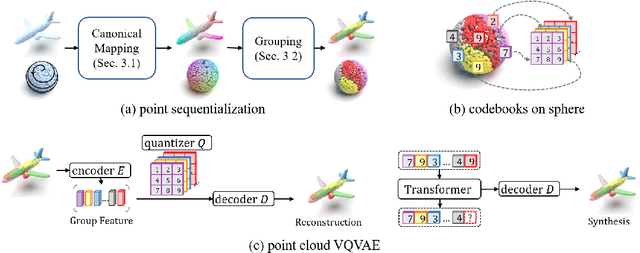

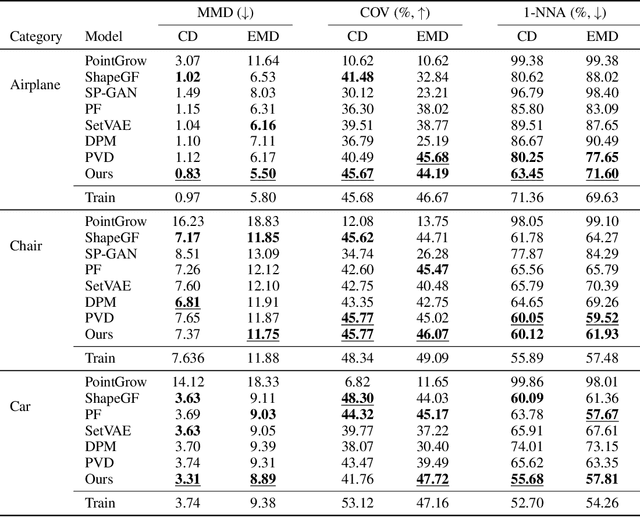

Abstract:With the capacity of modeling long-range dependencies in sequential data, transformers have shown remarkable performances in a variety of generative tasks such as image, audio, and text generation. Yet, taming them in generating less structured and voluminous data formats such as high-resolution point clouds have seldom been explored due to ambiguous sequentialization processes and infeasible computation burden. In this paper, we aim to further exploit the power of transformers and employ them for the task of 3D point cloud generation. The key idea is to decompose point clouds of one category into semantically aligned sequences of shape compositions, via a learned canonical space. These shape compositions can then be quantized and used to learn a context-rich composition codebook for point cloud generation. Experimental results on point cloud reconstruction and unconditional generation show that our model performs favorably against state-of-the-art approaches. Furthermore, our model can be easily extended to multi-modal shape completion as an application for conditional shape generation.
Learning 3D Dense Correspondence via Canonical Point Autoencoder
Jul 10, 2021

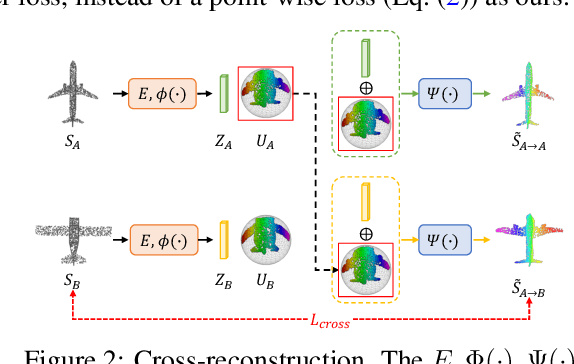
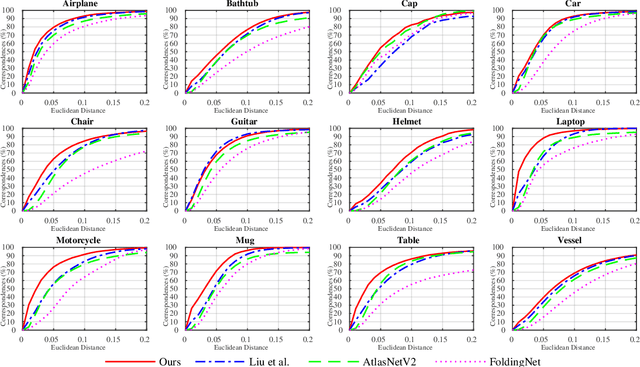
Abstract:We propose a canonical point autoencoder (CPAE) that predicts dense correspondences between 3D shapes of the same category. The autoencoder performs two key functions: (a) encoding an arbitrarily ordered point cloud to a canonical primitive, e.g., a sphere, and (b) decoding the primitive back to the original input instance shape. As being placed in the bottleneck, this primitive plays a key role to map all the unordered point clouds on the canonical surface and to be reconstructed in an ordered fashion. Once trained, points from different shape instances that are mapped to the same locations on the primitive surface are determined to be a pair of correspondence. Our method does not require any form of annotation or self-supervised part segmentation network and can handle unaligned input point clouds. Experimental results on 3D semantic keypoint transfer and part segmentation transfer show that our model performs favorably against state-of-the-art correspondence learning methods.
InstaNAS: Instance-aware Neural Architecture Search
Nov 26, 2018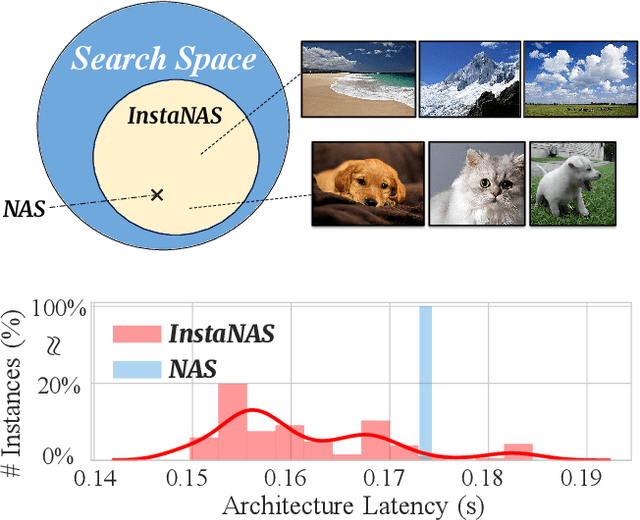
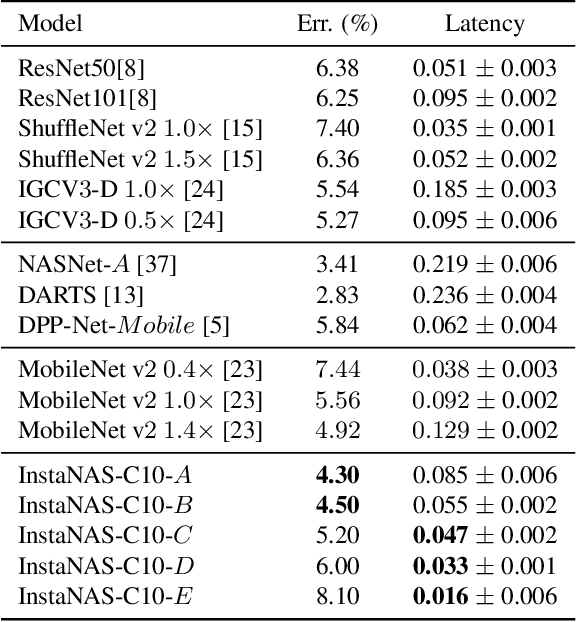

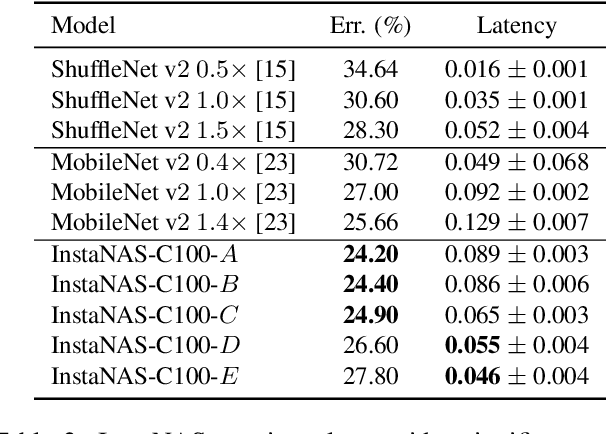
Abstract:Neural Architecture Search (NAS) aims at finding one "single" architecture that achieves the best accuracy for a given task such as image recognition.In this paper, we study the instance-level variation,and demonstrate that instance-awareness is an important yet currently missing component of NAS. Based on this observation, we propose InstaNAS for searching toward instance-level architectures;the controller is trained to search and form a "distribution of architectures" instead of a single final architecture. Then during the inference phase, the controller selects an architecture from the distribution, tailored for each unseen image to achieve both high accuracy and short latency. The experimental results show that InstaNAS reduces the inference latency without compromising classification accuracy. On average, InstaNAS achieves 48.9% latency reduction on CIFAR-10 and 40.2% latency reduction on CIFAR-100 with respect to MobileNetV2 architecture.
Visual Relationship Prediction via Label Clustering and Incorporation of Depth Information
Sep 09, 2018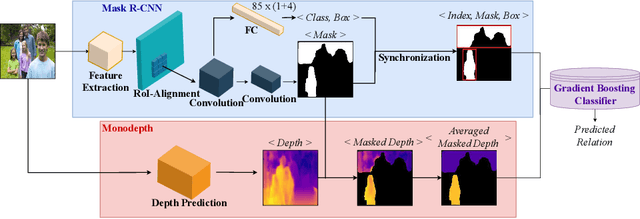

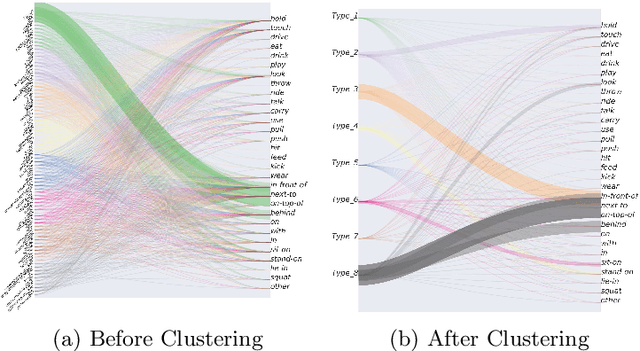
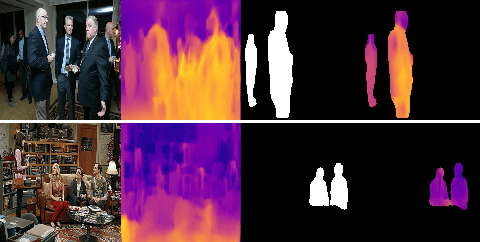
Abstract:In this paper, we investigate the use of an unsupervised label clustering technique and demonstrate that it enables substantial improvements in visual relationship prediction accuracy on the Person in Context (PIC) dataset. We propose to group object labels with similar patterns of relationship distribution in the dataset into fewer categories. Label clustering not only mitigates both the large classification space and class imbalance issues, but also potentially increases data samples for each clustered category. We further propose to incorporate depth information as an additional feature into the instance segmentation model. The additional depth prediction path supplements the relationship prediction model in a way that bounding boxes or segmentation masks are unable to deliver. We have rigorously evaluated the proposed techniques and performed various ablation analysis to validate the benefits of them.
 Add to Chrome
Add to Chrome Add to Firefox
Add to Firefox Add to Edge
Add to Edge